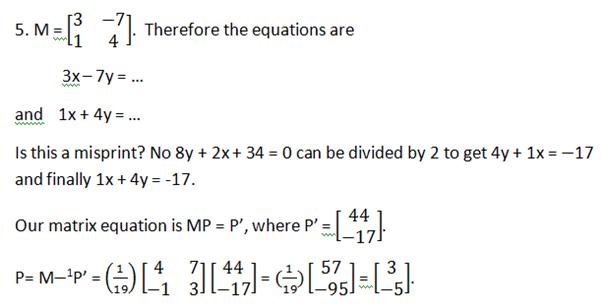After a
lesson on the factor theorem, the teacher assigns the following homework
problem.
“A cubic polynomial f(x) has a factor x and
f(x) – f(x–1) = 3x2 – 5x. … Find f(x).”
(Question
28, page 97, New Additional Mathematics by Ho Soo thong and Khor Nyak Hiong)
Johnny
begins as follows. As f(x) is cubic, he reasons that it will factorise as x(x –
a)(x – b).
Consequently,
Johnny defines f(x) in Wx Maxima. (A free computer algebra system that he downloaded
from http://sourceforge.net/projects/wxmaxima/
.
Unfortunately, Johnny cannot use Wx Maxima on the exam.)
Note that (%i1) is “input 1” and (%o1) is “output 1”.
In a very
straight-forward way, f(x) – f(x–1) is:
As the textbook
has told Johnny that expression %o2 is identical to 3x2 – 5x, he
inputs
Next he simplifies:
On
comparing the coefficients of x Johnny sees that
–2b –2a
– 3 = –5
Thus, a =
1 – b Equation (1)
As there is
no constant term
(a + 1)b + a + 1 = 0 Equation (2)
Johnny substitutes
for a:
(1 – b + 1)b + 1 – b + 1 = 0
– b2 + b + 2 = 0
(– b + 2) (b + 1) = 0
b = – 1 or b =2
To solve
for a, he substitutes back into a = 1 – b.
If b = – 1, a = 2 or if b = 2, a = –1.
Johnny realizes
that it is immaterial which label goes with which number. He has established that, written in factored
form, f(x) = x(x – –1) (x – 2) = x(x + 1)(x – 2).
Alternatively,
Mary starts with f(x) – f(x–1) = 3x2 – 5x and substitutes 0 for x,
everywhere.
She gets
f(0) – f(0 – 1) = 3(0)2 – 5(0) = 0
However she
knows that f(0) itself evaluates to zero:
f(0) = 0(x –
a) (x – b) = ‘zero’ times ‘other stuff’
= 0.
Therefore,
0 – f(0 –
1) = 0
It follows that
f(– 1) = 0
Mary
applies the factor theorem, for any f(a) = 0 she knows (x –a) is a factor of f.
Therefore (x – – 1)
= (x + 1) is a factor of f.
= (x + 1) is a factor of f.
Iteratively,
Mary lets x = 1
f(1) – f(1–1)
= 3(1)2 – 5(1)
f(1) – f(0)
= –2
Once again
she substitutes f(0) =0, so
f(1) – 0 = –2
f(1) = –2 ≠
0, so (x – 1) is not a factor of f.
Therefore
she continues and lets x = 2.
f(2) – f(2–1)
= 3(2)2 – 5(2)
f(2) – f(1)
= 3(2)2 – 5(2)
She
substitutes for f(1).
f(2) – (–2)
= 2
f(2) + 2 =
2
f(2) = 0,
i.e., she knows (x – 2) is also a factor of f(x). Since f is a cubic function Mary
knows it has exactly three factors. She
writes f(x) = x(x + 1)(x – 2).
Both
students have successfully completed their homework. Johnny has used the notion of function
identity and successfully solved a pair of simultaneous equations to find his
solution. He made some use of the
computer but could have expanded everything by hand if necessary. Mary has been
more traditional and done all her calculations with pencil and paper. Also, she
has directly applied the factor theorem itself, which is more in line with the
teacher’s expectations. Full marks to
both students.










